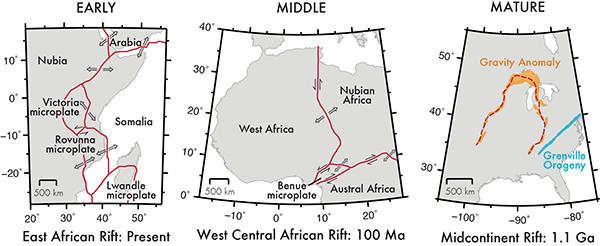
by Naomi Lubick Monday, July 28, 2014

Analogs for the various life stages of the Midcontinent Rift can be seen today. The early rift looked like today's East African Rift, with major plates pulling apart, separated by microplates. At middle age, it was similar to the West Central African Rift, where faulting during the opening of the South Atlantic during the Mesozoic created four microplates. Looking at the progression could help geologists understand how the Midcontinent Rift evolved, says co-author Seth Stein, a geophysicist at Northwestern University. Credit: Kathleen Cantner, AGI.
But now, Carol Stein of the University of Illinois at Chicago and her colleagues have offered a new possibility. Stein and colleagues suggest the Midcontinent Rift was related to the breakup of a supercontinent and to the early stages of a young ocean basin opening — similar to what is happening today in East Africa’s Great Rift Valley — that preceded the Atlantic. The findings could have implications for how geologists view early plate tectonics, and cast new light on the New Madrid Fault Zone, formed 500 million years later and home to earthquake-producing faults in Arkansas, Missouri and Tennessee that seriously rocked the region in 1811 and 1812.
Making the connection to a larger continental breakup was not easy: Most of the rocks that tell the story are now buried beneath younger sediments or have been subducted into Earth’s mantle. So Stein and her team turned to data on the wandering paths of the paleomagnetic poles, gravity anomalies, and seemingly unrelated outcrops of mafic rocks in Canada, the U.S., Bolivia and Brazil.
The team assembled paleomagnetic data from across the North American continent and several localities in Brazil. They calculated the paths of polar wander recorded in rocks on the continents, which translate to the movements of the rocks in time and space over millions of years, to show that the continents began pulling apart from one another about 1.1 billion years ago in a lateral motion. That means that what we know now as North America and Brazil were once part of the Laurentian and Amazonian continents, respectively, swinging past each other in opposite directions. The team also cites mafic igneous rocks, which are typically related to rifting, in southern Amazonia that are directly related to rocks in northern Appalachia, further linking Laurentia and Amazonia.
The team then took gravity anomaly data collected from North America and compared the very dense rocks of the Midcontinent Rift to similarly dense bodies nearby in the North American craton, including some to the southeast known as the Fort Wayne Rift and the East Continent Gravity High. These two likely rifts run along the edge of what’s known as the Grenville Front, the western edge of the Grenville Orogeny, a mountain-building event that unfolded at about the same time that the Midcontinent Rift formed and the supercontinent Rodinia came together.
Taken together, the timing of the continental movements, the related outcrops and the similar gravitational anomalies across the Laurentia and Amazonia led Stein and her colleagues to suggest in Geophysical Research Letters that the Midcontinent Rift was likely the first in a series of rifts formed at that time. But it failed as the later rifts formed to the east, one of which eventually gave rise to an ocean, an antecedent to the Atlantic.
Stein’s team’s model shows that “Amazonia was the first straw to break, and once that happened, the rifting happened more easily,” says Michael Wysession, a geophysicist at Washington University in St. Louis who wasn’t involved with the new research. The strain from Laurentia and Amazonia pulling apart “went into Amazonia, and so the [Midcontinent Rift] shut down,” he says. The timing of the cooling of the outcrops the team cites from North America and Brazil, and their similar coincidence with the paleomagnetic poles, are also persuasive, he says.
The model is the first “that links the formation of this particular continental rift to the opening of the major ocean at that time through plate tectonic processes,” says Anke Friedrich of the Ludwig-Maximilians University in Munich, Germany, who has worked with some of the co-authors but was not involved in the study. By piecing together the missing geologic record, she adds, “they are reaching into a black box and raising very fundamental questions” about plate tectonics. Friedrich says the team’s findings will factor in the current debate over how rifts begin, particularly in strong continental crust that composes a craton. Breaks might rip along older faults that are weaknesses in that crust, or other characteristics like the presence of water might come into play, weakening the crust.
“It’s rather common for rifting to initiate over a broad region and for only some rift faults to be successful, while others are abandoned,” says Stephen Marshak of the University of Illinois at Urbana-Champaign, who also has worked with some of the researchers on projects through EarthScope. The new proposal implies similarities between the Midcontinent Rift and the system in the eastern U.S. during the Mesozoic, where early phases of the rift that pulled apart the supercontinent Pangaea stalled as rifting “stepped eastward.”
The study raises the question, Marshak adds, of whether other rifts in the Midwest — such as the Reelfoot Rift, of which the New Madrid Fault Zone is a part — represent reactivation of still older rifts.
© 2008-2021. All rights reserved. Any copying, redistribution or retransmission of any of the contents of this service without the expressed written permission of the American Geosciences Institute is expressly prohibited. Click here for all copyright requests.